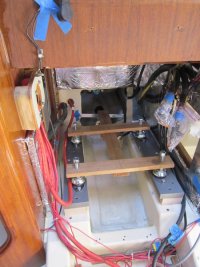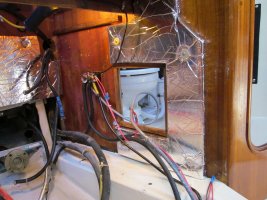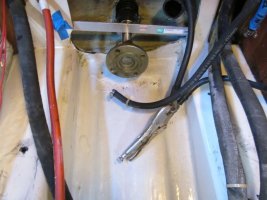Since, for several reasons, this project needed to be done at the slip, I needed to lock the shaft in position. Totally.
It was believed to be well-aligned, and it could not be allowed to move forward and relax the spring-bellows in the PSS seal and allow water to run in.
Since the Olson has a molded frp bulkhead panel right behind the engine, there was room to mount a piece of angle aluminum metal. It was screwed to the bulkhead and then U-bolted to the shaft. We did not not unbolt the old engine or coupler until this was done.
Once the engine was hoisted out we used a rigid wood pattern provided by the Betamarine dealer to position the mounting level for the new engine.
Note that this required both raising each side, and setting a proper angle (about 10 degrees) to let the new mounts rest on.
I should note that the angle was not a change from the former Universal diesel, because that engine used "riser blocks" for all four mounts and the front ones were at least an inch higher than the rear ones.
The new engine mounts are bolted into threaded holes in the top aluminum bar pieces, and the correct angle was accomplished by a shaped piece of rigid foam for each side. The foam was then wrapped in fiberglass.
The aluminum bar stock was also milled to fit around some of the engine parts. Finally the aluminum was hard-coat anodized.
When the new engine was lowered in, the new risers were bolted down into the fiberglass molded bed logs (and into oak underneath) with threaded bolts. These were tapped into new-cut threads. They torqued down very very solidly.
Once the old engine was out I cleaned up the engine pan - not too hard since EY had molded it out with a slick gel coat surface as part of the bed log molding. I cleaned up the sides from ancient glue where the original sound foam was long gone. The starboard side had a quarter inch gap where the teak plywood did not quite meet the fiberglass, and this was filled with thickened epoxy.
The new foam was sealed in with mylar tape on all edges. It was installed with spray glue, and then had fasteners with fender washers added for all corners.
Note: the vice-grip was temporarily there to keep 12 volt grounding connected for powering the bilge pumps (emergency) while the main house bank that resides in front of the engine was removed for several months.
Edit: Link to Christian's excellent engine noise reduction foam upgrade.
https://ericsonyachts.org/ie/ubs/engine-noise-insulation-upgrade.756/


